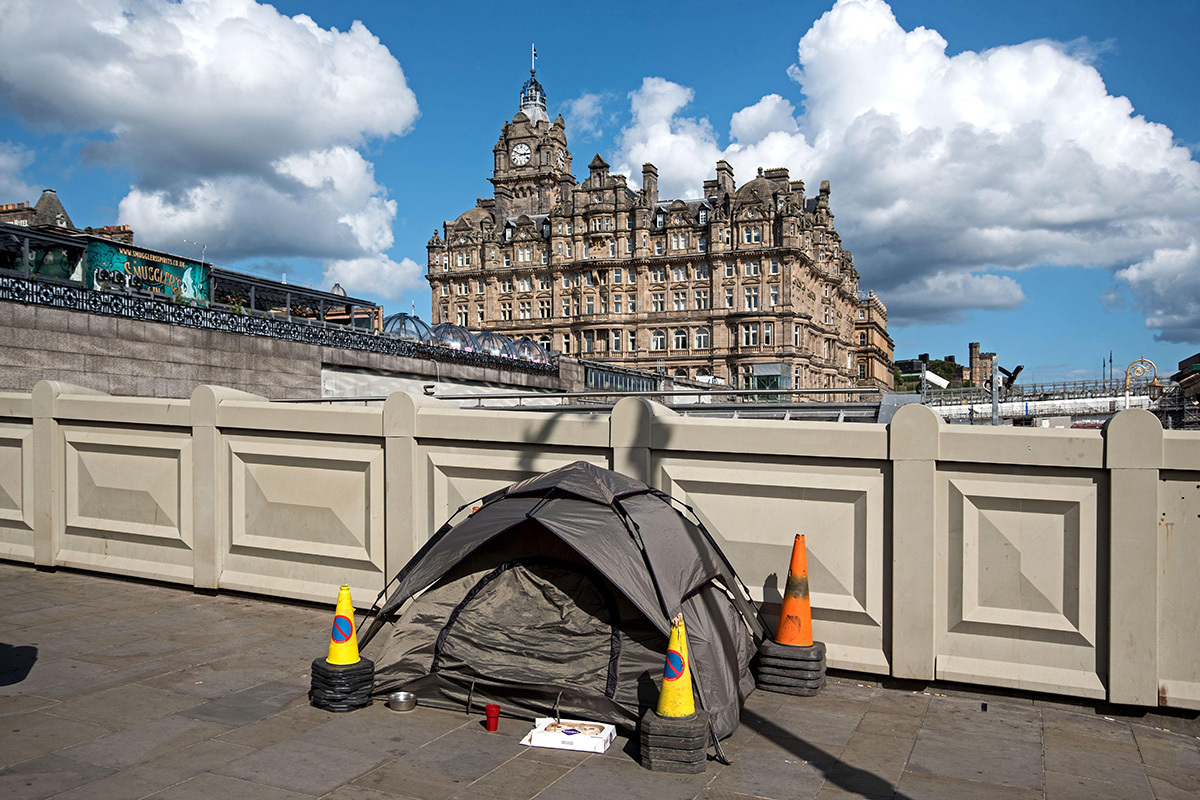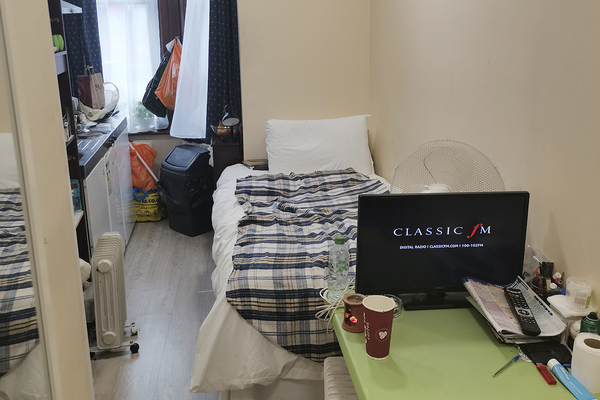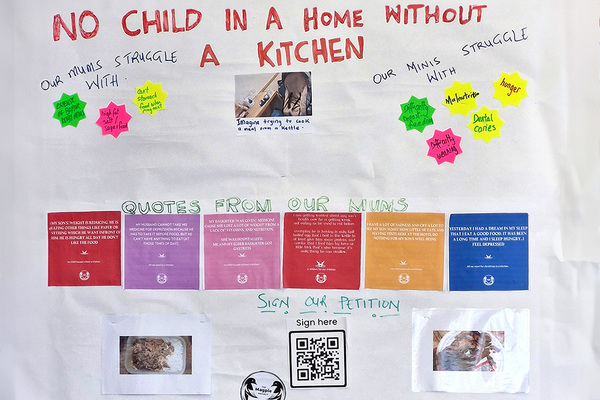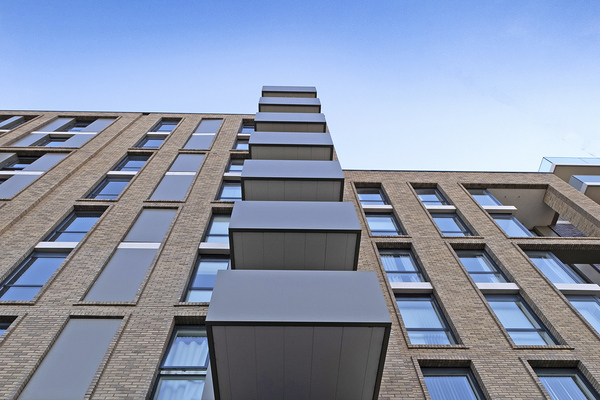You are viewing 1 of your 1 free articles
Scotland aimed to cut out temporary accommodation for homeless people – but now it is spending more
Scotland has world-leading legislation meant to prevent homelessness and rapidly rehouse people. Yet an Inside Housing investigation has found spending on temporary accommodation is on the rise. So, what are the reasons and what are the implications for the future of Scottish housing policy? James Riding reports

Scotland has some of the UK’s strongest homelessness protections, including rapid rehousing rules meant to cut the use of temporary accommodation. Yet, last financial year, Scottish councils spent over £160m on temporary accommodation – a rise of 50% in only three years, uncovered by Inside Housing through a Freedom of Information request to all 32 Scottish councils.
Why are the numbers still going up? And how will council finances cope as they increasingly resort to expensive hotels and private homes to meet their statutory duties?
The council with a 1,400% rise
We asked councils how much they had spent on placing people in temporary accommodation over the past four years. Some responses were particularly dramatic. East Renfrewshire Council experienced the largest percentage rise, as spending jumped 1,395% – from £36,400 in 2019-20 to £544,300 in 2022-23.
An East Renfrewshire Council spokesperson says homelessness applications rose 31% in this period, and the total number of nights people spent in temporary accommodation rose 84%. The council attributes this to factors such as higher mortgage defaults and evictions, low numbers of stock and slow turnover, fast-tracked asylum claims, and humanitarian crises in Ukraine and Syria. Scottish government policy changes also played a part, the council says, such as the removal of rules that allowed councils to ask someone to prove their connection to the local area before being given housing.
“East Renfrewshire is a small local authority, with just over 3,000 mainstream properties; our lets average 275 per year, of which up to 70% are allocated to homeless households,” they add. “We’ve increased our temporary stock portfolio by over 40% across the period and this is continuing to rise. We’ve also had to significantly increase our spot purchase of emergency B&B accommodation to meet our statutory obligations.”
Edinburgh had the next largest percentage increase, of 193%. Jane Meagher, portfolio holder for housing and homelessness at City of Edinburgh Council, tells Inside Housing the increased spending arises from the fact that “fundamentally, we don’t have sufficient housing to meet the accommodation needs of this growing city”.
The Scottish capital has the lowest percentage of social rented homes in the country, she says, while market rents rose 16% between 2022 and 2023, higher than any other UK city.
West Lothian Council faced a 164% rise over three years. A spokesperson says it faces a lack of adequate resources, legislative changes adding additional duties, and demand from refugee schemes as people are given the right to remain and access housing.
“The ability to move people quickly through the housing system is simply no longer possible due to the lack of permanent housing options. This has created unsustainable pressures in temporary accommodation and significant reliance on B&Bs,” they added.
Edinburgh spends by far the most on temporary accommodation each year, and the cost has risen from £16.7m in 2019-20 to £49m in 2022-23.
“We do not want to be spending public money in this way,” says Ms Meagher. “We’d much rather be spending the money on things like housebuilding – in other words, solving the problem rather than putting what is effectively a sticking plaster over the problem. However, we have, quite rightly, a statutory duty to accommodate anybody who presents as homeless, and therefore we’re obliged to accommodate in the way that we are.”
The momentum continued into 2023-24. For example, Glasgow City Council spent £19.2m on temporary accommodation in the first five months of this financial year, putting it on course to be its highest spending yet.
Local authority by spending on temporary accommodation
Local authority | 2022-23 | Percentage change (annual) | Percentage change (3 years) |
City of Edinburgh | £49,001,631 | 31% | 193% |
Glasgow City | £36,609,858 | 20% | 40% |
South Lanarkshire | £12,290,626 | 2% | 22% |
North Lanarkshire | £11,388,360 | 11% | 6% |
Fife | £7,235,113 | 28% | 76% |
Dundee | £6,178,598 | 5% | 22% |
Aberdeen City | £4,735,617 | 8% | -20% |
West Lothian | £3,933,789 | 17% | 164% |
East Ayrshire | £3,193,406 | 6% | 41% |
Renfrewshire | £3,031,831 | 24% | 36% |
A Glasgow spokesperson says the city was facing “unprecedented levels of demand” for temporary accommodation. The recent hike in spending is “largely down to the UK government’s decision to accelerate the asylum decision process”, but other factors have led to “increased numbers of people travelling to Glasgow from across Scotland, as well as Ireland and London, in search of accommodation”. The council has expanded its use of B&Bs to meet demands for homelessness assistance and avoid people having to sleep rough.
Six councils experienced a reduction in spending, including Aberdeenshire, which brought all its hostels in-house in 2022-23, so spending nothing on external organisations that year.
Since 2018, Scottish councils have been required to have a rapid rehousing transition plan in place to reduce time spent in temporary accommodation to a minimum. Furthermore, under the Homeless Persons (Unsuitable Accommodation) (Scotland) Order, which came into force in 2021, local authorities can only use B&B-type accommodation for any homeless person for a maximum of seven days. While this sounds great, are councils actually delivering what they are meant to? The numbers show they are increasingly falling short – according to official data, 2022-23 saw 3,535 breaches of the order, a 74% increase in just two years.
In December 2023, the Scottish Housing Regulator singled out Glasgow City Council and City of Edinburgh Council’s inability to provide temporary accommodation, saying they were impacted by “systemic failure”.
As of October 2023, Glasgow City Council had 683 households in homelessness accommodation in the city that breached the order. Meanwhile, City of Edinburgh reported an average of 25% of households were living in temporary accommodation that breached the order.
Ms Meagher puts it down to hard cash: “There simply is insufficient funding for us to be able to carry out satisfactorily our statutory duty.”
“Particularly during peak times, people pay hundreds of pounds for very basic rooms in this city. And, of course, that affects what landlords and hotel owners can expect to get from us,” she says. She added that the council doubled its homelessness budget between 2020-21 and 2023-24, deployed 90 extra homelessness prevention staff, and now offers financial and benefits advice to people at risk of homelessness.
‘Policy ambition’
Dr Beth Watts-Cobbe, senior research fellow at the Institute for Social Policy, Housing, Equalities Research at Heriot-Watt University, says that the Scottish government has had “really significant policy ambition” in terms of homelessness, but that it has not provided enough support to councils. The Unsuitable Accommodation Order is a good example, she says. “Alongside legal change like that, you need specific, locally targeted, bespoke action to address the reasons why, for example, in Edinburgh there is such a big reliance on unsuitable temporary accommodation.”
Without the government’s interventions, things “may well have been worse”. But, she says: “Government have said they want to move towards rapid rehousing and reduce numbers in temporary accommodation, and we’ve seen all the trends go in the other direction.”
The number of households in temporary accommodation in Scotland rose 37% between 2019 and 2023 to 15,039. In the same period, this figure in England rose 23% to 104,540.
1,395%
Rise in spending on temporary accommodation by East Renfrewshire Council over three years
£49m
Edinburgh’s temporary accommodation spend, 2022-23
90
Extra homelessness prevention staff employed by Glasgow between 2020-21 and 2023-24
The Scottish government has promised to include anti-homelessness duties for landlords in a new housing bill, due to be published later this year. However, since councils are struggling to meet their existing legal duties, whether local authorities will be able to deliver them is another matter.
“Local authorities are feeling really embattled,” says Dr Watts-Cobbe, “and the layering on top of more and more ambitious and onerous legal duties and requirements on them without requisite funding and support and without recognising those localised challenges is, I think, really starting to bite.”
Scottish housing minister Paul McLennan told Inside Housing: “Scotland has the strongest rights across the UK nations for people experiencing homelessness, and anyone threatened with or experiencing homelessness is entitled to temporary accommodation.
“We know that the cost of temporary accommodation – both to the household and local authorities – can be expensive, which is why we have committed to reducing the use of temporary accommodation by 2026.
“We will invest £556m in affordable homes across Scotland next year and continue to work with partners to increase the delivery of more affordable homes, the majority of which will be for social rent, including supporting the acquisition of existing properties.”
Alison Watson, director of Shelter Scotland, says: “There is undoubtedly a housing emergency in Scotland and a chronic over-reliance on temporary accommodation is one of the many ways in which it manifests. It is a costly form of accommodation for both local authorities and individuals, making the provision of affordable temporary accommodation a challenge.”
Some say that achieving a cut in temporary accommodation means looking at new options. For example, Dr Watts-Cobbe says, allow local authorities to rehouse people into other forms of stable, suitable accommodation, not just social housing. This proposal faces opposition from other parts of the homelessness sector, who are worried it could weaken people’s rights.
Scotland’s temporary accommodation challenges cannot be divorced from the fact that social housing supply is insufficient to meet demand. Given the Scottish government’s decision in December to cut the budget for its Affordable Homes Supply Programme by 26% for 2024-25, councils’ temporary accommodation bills are only likely to rise in the coming years.
Ms Meagher says: “There’s more money coming out of the public purse to pay for temporary accommodation, when really what we need is a complete overhaul of the system, so that we’re spending money to meet the fundamental problem: the lack of suitable housing.”
Recent longform articles by James Riding
The Inside Housing interview with Michael Gove: cross-party realisation we need more social rent
Housing secretary Michael Gove sits down with James Riding, in an exclusive interview covering how to build more social rent, the role for landowners, and those letters to housing association chief executives
A timeline of housing history – the 1990s
As Inside Housing turns 40 years old, we are looking back over four decades of housing history, as reported by the publication. James Riding takes a walk down memory lane to the ’90s, in our second instalment
Five things we learned from the report on Housing First pilots
The outcomes of the Housing First scheme have been detailed in a report published by the Department of Levelling Up, Housing and Communities. James Riding goes through five key takeaways
Sign up for our Scotland newsletter
Already have an account? Click here to manage your newsletters













